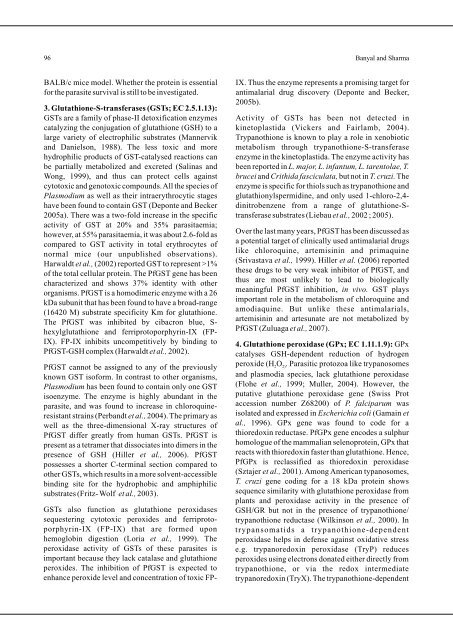December 2007 - The Indian Society for Parasitology
December 2007 - The Indian Society for Parasitology
December 2007 - The Indian Society for Parasitology
You also want an ePaper? Increase the reach of your titles
YUMPU automatically turns print PDFs into web optimized ePapers that Google loves.
96 Banyal and SharmaBALB/c mice model. Whether the protein is essential IX. Thus the enzyme represents a promising target <strong>for</strong><strong>for</strong> the parasite survival is still to be investigated. antimalarial drug discovery (Deponte and Becker,3. Glutathione-S-transferases (GSTs; EC 2.5.1.13):2005b).GSTs are a family of phase-II detoxification enzymes Activity of GSTs has been not detected incatalyzing the conjugation of glutathione (GSH) to a kinetoplastida (Vickers and Fairlamb, 2004).large variety of electrophilic substrates (Mannervik Trypanothione is known to play a role in xenobioticand Danielson, 1988). <strong>The</strong> less toxic and more metabolism through trypanothione-S-transferasehydrophilic products of GST-catalysed reactions can enzyme in the kinetoplastida. <strong>The</strong> enzyme activity hasbe partially metabolized and excreted (Salinas and been reported in L. major, L. infantum, L. tarentolae, T.Wong, 1999), and thus can protect cells against brucei and Crithida fasciculata, but not in T. cruzi. <strong>The</strong>cytotoxic and genotoxic compounds. All the species of enzyme is specific <strong>for</strong> thiols such as trypanothione andPlasmodium as well as their intraerythrocytic stages glutathionylspermidine, and only used 1-chloro-2,4-have been found to contain GST (Deponte and Becker dinitrobenzene from a range of glutathione-S-2005a). <strong>The</strong>re was a two-fold increase in the specific transferase substrates (Liebau et al., 2002 ; 2005).activity of GST at 20% and 35% parasitaemia;however, at 55% parasitaemia, it was about 2.6-fold asOver the last many years, PfGST has been discussed ascompared to GST activity in total erythrocytes ofa potential target of clinically used antimalarial drugsnormal mice (our unpublished observations).like chloroquine, artemisinin and primaquineHarwaldt et al., (2002) reported GST to represent >1%(Srivastava et al., 1999). Hiller et al. (2006) reportedof the total cellular protein. <strong>The</strong> PfGST gene has beenthese drugs to be very weak inhibitor of PfGST, andcharacterized and shows 37% identity with otherthus are most unlikely to lead to biologicallyorganisms. PfGST is a homodimeric enzyme with a 26meaningful PfGST inhibition, in vivo. GST playskDa subunit that has been found to have a broad-rangeimportant role in the metabolism of chloroquine and(16420 M) substrate specificity Km <strong>for</strong> glutathione.amodiaquine. But unlike these antimalarials,<strong>The</strong> PfGST was inhibited by cibacron blue, S-artemisinin and artesunate are not metabolized byhexylglutathione and ferriprotoporphyrin-IX (FP-PfGST (Zuluaga et al., <strong>2007</strong>).IX). FP-IX inhibits uncompetitively by binding to 4. Glutathione peroxidase (GPx; EC 1.11.1.9): GPxPfGST-GSH complex (Harwaldt et al., 2002).catalyses GSH-dependent reduction of hydrogenPfGST cannot be assigned to any of the previouslyperoxide (H2O 2) . Parasitic protozoa like trypanosomesknown GST iso<strong>for</strong>m. In contrast to other organisms, and plasmodia species, lack glutathione peroxidasePlasmodium has been found to contain only one GST (Flohe et al., 1999; Muller, 2004). However, theisoenzyme. <strong>The</strong> enzyme is highly abundant in the putative glutathione peroxidase gene (Swiss Protparasite, and was found to increase in chloroquineisolatedand expressed in Escherichia coli (Gamain etaccession number Z68200) of P. falciparum wasresistant strains (Perbandt et al., 2004). <strong>The</strong> primary aswell as the three-dimensional X-ray structures of al., 1996). GPx gene was found to code <strong>for</strong> aPfGST differ greatly from human GSTs. PfGST is thioredoxin reductase. PfGPx gene encodes a sulphurpresent as a tetramer that dissociates into dimers in the homologue of the mammalian selenoprotein, GPx thatpresence of GSH (Hiller et al., 2006). PfGST reacts with thioredoxin faster than glutathione. Hence,possesses a shorter C-terminal section compared to PfGPx is reclassified as thioredoxin peroxidaseother GSTs, which results in a more solvent-accessible (Sztajer et al., 2001). Among American typanosomes,binding site <strong>for</strong> the hydrophobic and amphiphilic T. cruzi gene coding <strong>for</strong> a 18 kDa protein showssubstrates (Fritz- Wolf et al., 2003).sequence similarity with glutathione peroxidase fromplants and peroxidase activity in the presence ofGSTs also function as glutathione peroxidases GSH/GR but not in the presence of trypanothione/sequestering cytotoxic peroxides and ferriproto- trypanothione reductase (Wilkinson et al., 2000). Inporphyrin-IX (FP-IX) that are <strong>for</strong>med upon trypansomatids a trypanothione-dependenthemoglobin digestion (Loria et al., 1999). <strong>The</strong> peroxidase helps in defense against oxidative stressperoxidase activity of GSTs of these parasites is e.g. trypanoredoxin peroxidase (TryP) reducesimportant because they lack catalase and glutathione peroxides using electrons donated either directly fromperoxides. <strong>The</strong> inhibition of PfGST is expected to trypanothione, or via the redox intermediateenhance peroxide level and concentration of toxic FP- trypanoredoxin (TryX). <strong>The</strong> trypanothione-dependent










